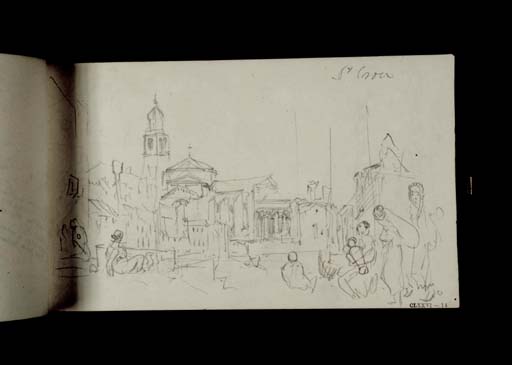Joseph Mallord William Turner The Tolentini (Church of Nicolò da Tolentino), Venice, from the Bridge on the Rio dei Tolentini 1819
Image 1 of 2
Joseph Mallord William Turner,
The Tolentini (Church of Nicolò da Tolentino), Venice, from the Bridge on the Rio dei Tolentini
1819
Joseph Mallord William Turner 1775–1851
Folio 14 Recto:
The Tolentini (Church of Nicolò da Tolentino), Venice, from the Bridge on the Rio dei Tolentini 1819
D14513
Turner Bequest CLXXVI 14
Turner Bequest CLXXVI 14
Pencil on white wove paper, 111 x 184 mm
Inscribed by Turner in pencil ‘St Croce’ top right
Inscribed by John Ruskin in red ink ‘14’ bottom right (now faint)
Stamped in black ‘CLXXVI – 14’ bottom right
Inscribed by Turner in pencil ‘St Croce’ top right
Inscribed by John Ruskin in red ink ‘14’ bottom right (now faint)
Stamped in black ‘CLXXVI – 14’ bottom right
Accepted by the nation as part of the Turner Bequest 1856
References
1909
A.J. Finberg, A Complete Inventory of the Drawings of the Turner Bequest, London 1909, vol.I, p.516, CLXXVI 14, as ‘“S. Croce”, chiesa della Giudecca’.
1930
A.J. Finberg, In Venice with Turner, London 1930, p.167, as ‘“S. Croce”, on the Giudecca’.
The Turner scholar C.F. Bell annotated Finberg’s 1909 Inventory entry (‘“S. Croce”, chiesa della Giudecca’), placing the last two words in square brackets: ‘This church and convent (suppressed in 1810) stood on the site of the Papadopoli Garden, now the car park at the tip of the Grand Canal’.1 Bell similarly annotated Finberg’s 1930 In Venice with Turner (‘“S. Croce”, on the Giudecca’), crossing out the last three words: ‘This church which was suppressed in 1810, stood on the site of the Papadopoli Gardens (motor car-park) at the western end of the Gd Canal’.2
Bell was right to dismiss Finberg’s supposition that the ‘St Croce’ of Turner’s written note was the church of that dedication on the Giudecca. In fact, the viewpoint is the footbridge at the entrance to the Rio di Tolentini, near the north-west entrance to the Grand Canal on the opposite side of Venice. To the south-south-east is the church of San Nicolò da Tolentino, known the Tolentini, with its massive buttresses and Corinthian western porch; the relative height of the tower above its central rotunda is somewhat exaggerated here.
The right-hand half of the scene has changed, with the long, high wall of the Papadopoli Gardens now running down that side of the canal beside the Fondamenta del Monastero, with a single column embedded at the corner nearest the bridge to mark the site of the (latterly) convent church of Santa Croce, which had been demolished in 1813.3 A slighter drawing in the contemporary Milan to Venice sketchbook (Tate D14480; Turner Bequest CLXXV 86a) appears to show the same scene from a little further back, with the whole bridge in the foreground.
Aside from two figures seated and looking towards the church, there is a group of three women in the right foreground: one seated with a baby on her lap, conversing with another turned towards her, apparently with a billowing veil, and followed by a third, also in a lace-trimmed veil, who seems to turn quizzically towards the artist. For a few pages with figure studies in isolation, see under folio 1 recto (D14489), and for other aspects of Venice on adjacent pages, see the sketchbook’s Introduction.
Matthew Imms
March 2017
Undated MS note by C.F. Bell (died 1966) in copy of Finberg 1909, Tate Britain Prints and Drawings Room, I, p.516.
Undated MS note by Bell (before 1936) in copy of Finberg 1930, Prints and Drawings Study Room, British Museum, London, p.167, as transcribed by Ian Warrell (undated notes, Tate catalogue files).
See Jeff Cotton, ‘The Lost Churches’, The Churches of Venice, accessed 15 February 2017, http://www.churchesofvenice.co.uk/demolished.htm#santacroc .
How to cite
Matthew Imms, ‘The Tolentini (Church of Nicolò da Tolentino), Venice, from the Bridge on the Rio dei Tolentini 1819 by Joseph Mallord William Turner’, catalogue entry, March 2017, in David Blayney Brown (ed.), J.M.W. Turner: Sketchbooks, Drawings and Watercolours, Tate Research Publication, July 2017, https://www


